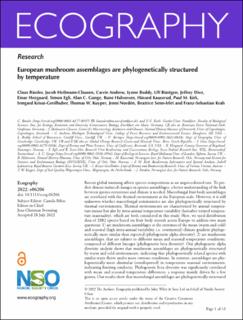| dc.contributor.author | Bässler, Claus | |
| dc.contributor.author | Heilmann-Clausen, Jacob | |
| dc.contributor.author | Andrew, Carrie | |
| dc.contributor.author | Boddy, Lynne | |
| dc.contributor.author | Büntgen, Ulf | |
| dc.contributor.author | Diez, Jeffrey | |
| dc.contributor.author | Heegaard, Einar | |
| dc.contributor.author | Egli, Simon | |
| dc.contributor.author | Gange, Alan C. | |
| dc.contributor.author | Halvorsen, Rune | |
| dc.contributor.author | Kauserud, Håvard | |
| dc.contributor.author | Kirk, Paul M. | |
| dc.contributor.author | Krisai-Greilhuber, Irmgard | |
| dc.contributor.author | Kuyper, Thomas W. | |
| dc.contributor.author | Nordén, Jenni | |
| dc.contributor.author | Senn-Irlet, Beatrice | |
| dc.contributor.author | Krah, Franz-Sebastian | |
| dc.coverage.spatial | Europe | en_US |
| dc.date.accessioned | 2022-09-14T13:32:48Z | |
| dc.date.available | 2022-09-14T13:32:48Z | |
| dc.date.created | 2022-09-08T09:13:17Z | |
| dc.date.issued | 2022 | |
| dc.identifier.issn | 0906-7590 | |
| dc.identifier.uri | https://hdl.handle.net/11250/3017886 | |
| dc.description.abstract | Recent global warming affects species compositions at an unprecedented rate. To predict climate-induced changes in species assemblages, a better understanding of the link between species occurrence and climate is needed. Macrofungal fruit body assemblages are correlated with the thermal environment at the European scale. However, it is still unknown whether macrofungal communities are also phylogenetically structured by thermal environments. Thermal environments are characterized by annual temperature means but also by intra-annual temperature variability (hereafter termed temperature seasonality), which are both considered in this study. Here, we used distribution data of 2882 species based on fruit body records across Europe to address two main questions: 1) are mushroom assemblages at the extremes of the mean (warm and cold) and seasonal (high intra-annual variability, i.e. continental) climate gradient phylogenetically more similar than expected (phylogenetic alpha diversity); 2) are mushroom assemblages, that are subject to different mean and seasonal temperature conditions, composed of different lineages (phylogenetic beta diversity). Our phylogenetic alpha diversity analysis shows that mushroom assemblages are phylogenetically structured by warm and cold environments, indicating that phylogenetically related species with similar traits thrive under more extreme conditions. In contrast, assemblages are phylogenetically more dissimilar (overdispersed) in temperature seasonal environments, indicating limiting similarity. Phylogenetic beta diversity was significantly correlated with mean and seasonal temperature differences, a response mainly driven by a few genera. Our results show that macrofungal assemblages are phylogenetically structured by temperature across Europe, suggesting phylogenetically constrained specialization towards temperature extremes. Predicted anthropogenic warming is likely to affect species composition and phylogenetic diversity with additional consequences for the carbon- and nutrient cycles. assembly processes, climate change, fungal diversity, null models, regional | en_US |
| dc.language.iso | eng | en_US |
| dc.rights | Navngivelse 4.0 Internasjonal | * |
| dc.rights.uri | http://creativecommons.org/licenses/by/4.0/deed.no | * |
| dc.title | European mushroom assemblages are phylogenetically structured by temperature | en_US |
| dc.title.alternative | European mushroom assemblages are phylogenetically structured by temperature | en_US |
| dc.type | Peer reviewed | en_US |
| dc.type | Journal article | en_US |
| dc.description.version | publishedVersion | en_US |
| dc.rights.holder | © 2022 The Authors | en_US |
| dc.subject.nsi | VDP::Zoologiske og botaniske fag: 480 | en_US |
| dc.subject.nsi | VDP::Zoology and botany: 480 | en_US |
| dc.source.journal | Ecography | en_US |
| dc.identifier.doi | 10.1111/ecog.06206 | |
| dc.identifier.cristin | 2049738 | |
| dc.relation.project | Norges forskningsråd: 500181 | en_US |
| cristin.ispublished | true | |
| cristin.fulltext | original | |
| cristin.qualitycode | 2 | |

